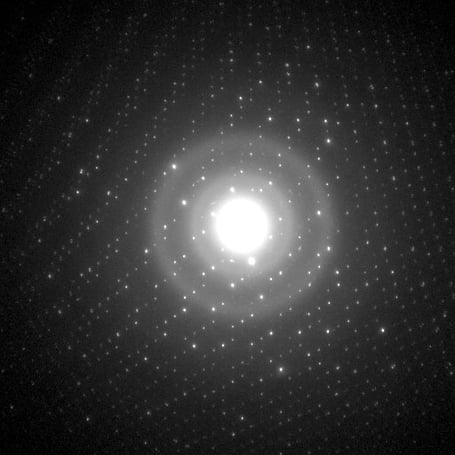How Precession Enhances STEM Microscopy
Understanding Precession And Its Role in STEM Technology
Extract more Information from
your Electron Diffraction Patterns

Electron beam precession is a key integrated feature of TESCAN TENSOR.
The ability to precess the electron beam means that the incident electron beam is tilted and continuously rotated about the central axis of the microscope. Electron beam precession must be carefully aligned to ensure that the precession pivot point is coincident with the surface of the specimen, and that the electron beam converges in the smallest possible, round spot.
This is achieved effortlessly and automatically, thanks to a unique electron column design and software automation that are both integrated into the fundamental design of the new system architecture of TESCAN TENSOR.

Precession-assisted 4D-STEM Measurement
TESCAN TENSOR allows you to easily operate with and without electron beam precession, over the full range of 4D-STEM measurements, notably Orientation and Phase mapping and Strain mapping, but also Virtual STEM and Diffraction Tomography.
Precession causes the Ewald sphere to rock through reciprocal space, which results in many positives:
-
The effects of dynamical electron interactions are minimized while maintaining the geometry of the diffraction pattern.
-
Many more reflections are visible in both zero- and higher-order zones (ZOLZ and HOLZ) are visible compared to a static Ewald sphere.
-
Intensities are integrated through the Bragg condition and are not dominated by complex contrast patterns.
Learn more about Precession Electron Diffraction from the animation.
Without dynamical diffraction artifacts, i.e., forbidden reflections, the resulting precession electron diffraction patterns are well suited for a variety of applications. Benefits include better differentiation of diffraction patterns when doing orientation/and phase mapping and improved precision in strain mapping. TESCAN TENSOR uses NanoMEGAS’ proven and well trusted ASTAR® software algorithms for template creation, pattern indexing, and orientation/phase mapping.
Higher order reflections also improve ab initio structure determination of nanocrystalline materials. For structural determination using precession-assisted electron diffraction tomography (3DED with precession, or 3DPED), TESCAN TENSOR offers the optionally available PETS Advanced software, a version of FZU’s PETS Enhanced that has been customized for TESCAN.
LEARN MORE
TESCAN TENSOR also excels in the wide range of STEM, 4D-STEM and Tomography measurements integrated in the system, accessible quickly also by novel users without exhaustive training and experience in (S)TEM operational procedures. Explore by clicking any of the links below.
Subscribe to the TESCAN TENSOR information channel
Receive news on a regular basis as we will continue to develop new and exciting 4D-STEM applications with our application development program partners.
Click or scan the QR code to subscribe.
Ready to discuss TESCAN TENSOR?
Please get in touch today.
Our global team will be available to answer questions about the TESCAN line of TENSOR solutions.




.png?width=200&height=200&name=qrcode_info.tescan.com%20(1).png)